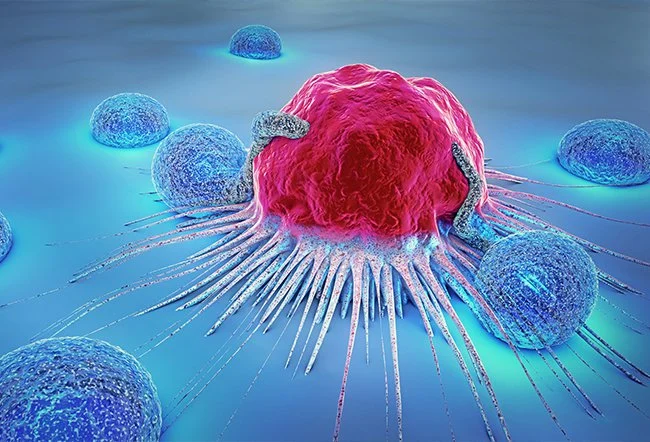
Lymphocytes are immune system cells that fight infection. This is where lymphoma, first appears. These cells can originate in the bone marrow, lymph nodes, spleen, thymus, and other organs, lymphocytes alter and overgrow when you have lymphoma.
The two primary kinds of lymphoma are as follows:
Different types of lymphocyte cells in Hodgkin Non-Hodgkin and Hodgkin lymphoma. Additionally, each form of lymphoma develops at a unique rate and uniquely reacts to therapy.

The outlook for lymphoma varies based on the type and stage of the disease, and it is relatively curable. Your doctor can help you determine the best course of action given the kind and stage of your condition.
Leukemia differs from lymphoma. Moreover, these malignancies all originate in various types of cells.
Additionally, lymphoma and lymphedemaa buildup of fluid that develops in body tissues when the lymphatic system is in harm, or has a blockageare not the same.
Also Read: Overview of Hodgkin's Lymphoma
A malignancy of the lymphatic system is lymphoma. Healthy B cells, T cells, or NK cells in the lymphatic system alter and expand out of control, which may result in a tumor, which is how lymphoma develops. Additionally, the term Non-Hodgkin lymphoma (NHL) refers to a class of lymphatic system malignancies. These malignancies can present with a variety of symptoms, physical examination findings, and treatments.
The majority of the body's tissues contain lymphatic tissue, therefore NHL can begin practically anywhere and spread, or metastasis, to almost any organ. It frequently starts in the bone marrow, liver, spleen, or lymph nodes. However, it can also affect the thyroid gland, brain, skin, intestines, stomach, or any other organ.
Knowing the specific type and subtype of lymphoma is crucial. The doctor can use such information to determine the best course of action and the prognosis, or likelihood, of a patient's recovery.
I, II, III, or IV denotes the stage of lymphoma, which reflects the amount of the tumour's dissemination (1 through 4). The most prevalent subtypes of lymphoma can benefit from this staging scheme. When the disease is discovered in other subtypes, it has frequently already spread to every part of the body. The prognostic indicators take on greater significance under these circumstances (see "International Prognostic Index" and "Functional state" below).
It's crucial to keep in mind that even stage IV lymphomas can frequently be successfully treated.
One of the following situations occurs:
One of the following conditions:
Both sides of the diaphragm have cancerous lymph node regions (stage III), or the cancer has migrated outside the lymph nodes (stage IV). The liver, bone marrow, or lungs are where lymphoma spreads most frequently. Depending on the NHL subtype, stage III-IV lymphomas are prevalent, still quite treatable, and frequently curable. Stages III and IV are now grouped because they receive the same care and have the same prognosis.
This illness is characterized by the cancer expanding or spreading when the patient is receiving therapy for the primary lymphoma. This is also referred to as NHL refractory.
Lymphoma that has returned after therapy is referred to as recurrent lymphoma. It might come back in the same spot where it started or somewhere else on the body. Recurrence might happen right away following the initial therapy or years later. The malignancy may need to be staged once more using the aforementioned system if there is a recurrence. NHL relapse is another name for this.
A malignancy of the lymphatic system is lymphoma. One of the numerous kinds of lymphoma is Hodgkin lymphoma, formerly known as Hodgkin's disease. Healthy lymphatic system cells alter and proliferate out of control to cause lymphoma. This unchecked growth may develop into a tumour, affect several lymphatic organs, or spread to other areas of the body.
Lymph nodes in the neck or the region between the lungs and behind the breastbone are most frequently impacted by Hodgkin lymphoma. It can also start in clusters of lymph nodes in the groin, the belly, or the pelvis.
Using the terminology "stage I" to "stage IV," Hodgkin lymphoma stages define the amount of the tumour's spread (1 through 4). Depending on whether or not a person is exhibiting particular symptoms, each stage may also be further separated into "A" and "B" categories.
One lymph node is affected by the disease. Or, less frequently in Hodgkin lymphoma, cancer has invaded one extra lymphatic organ or site (designated with the letter "E") but not any lymph node regions (stage IE).
Any of the aforementioned circumstances is true
The lymph nodes above and below the diaphragm, on both sides, have lymphoma.
One or more organs other than the lymph nodes have been affected by the disease. In most cases, the liver, bone marrow, or lungs are where Hodgkin lymphoma spreads.
Lymphoma that has returned after therapy is referred to as recurrent lymphoma. The location of the original lymphoma's recurrence or another area of the body are both possibilities. Recurrence can happen at any time, even years or even months after the initial therapy. There will be more testing to determine the amount of lymphoma recurrence if it develops. These examinations and scans frequently resemble those carried out at the time of the first diagnosis.

Depending on the stages of cancer (Lymphoma) diagnosed and the severity of its effects on your body, oncologists will plan your treatment and therapy.
Enhance Strength & Mobility in Your Journey
For personalized guidance on cancer treatments and complementary therapies, consult our experts atZenOnco.ioor call+91 9930709000
Reference: